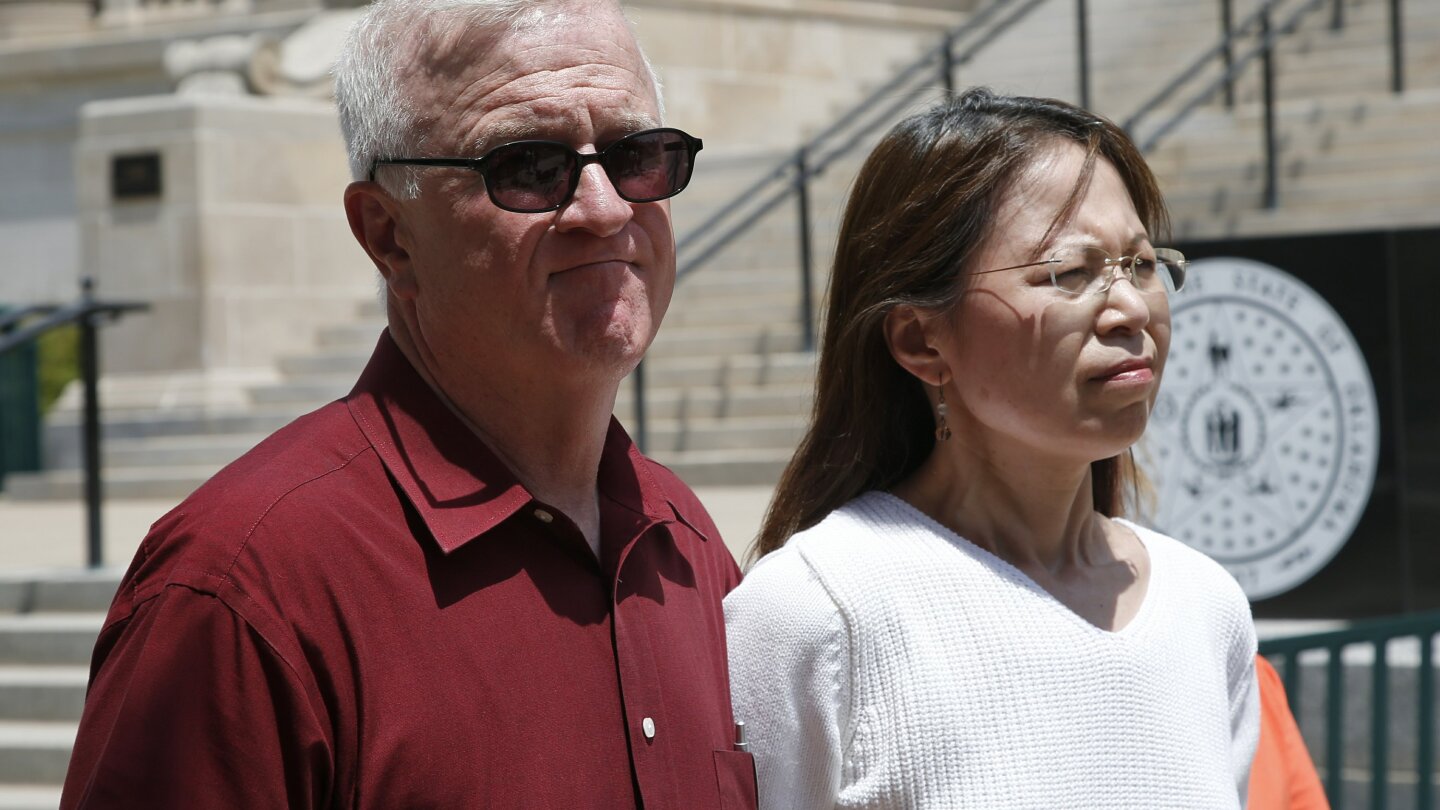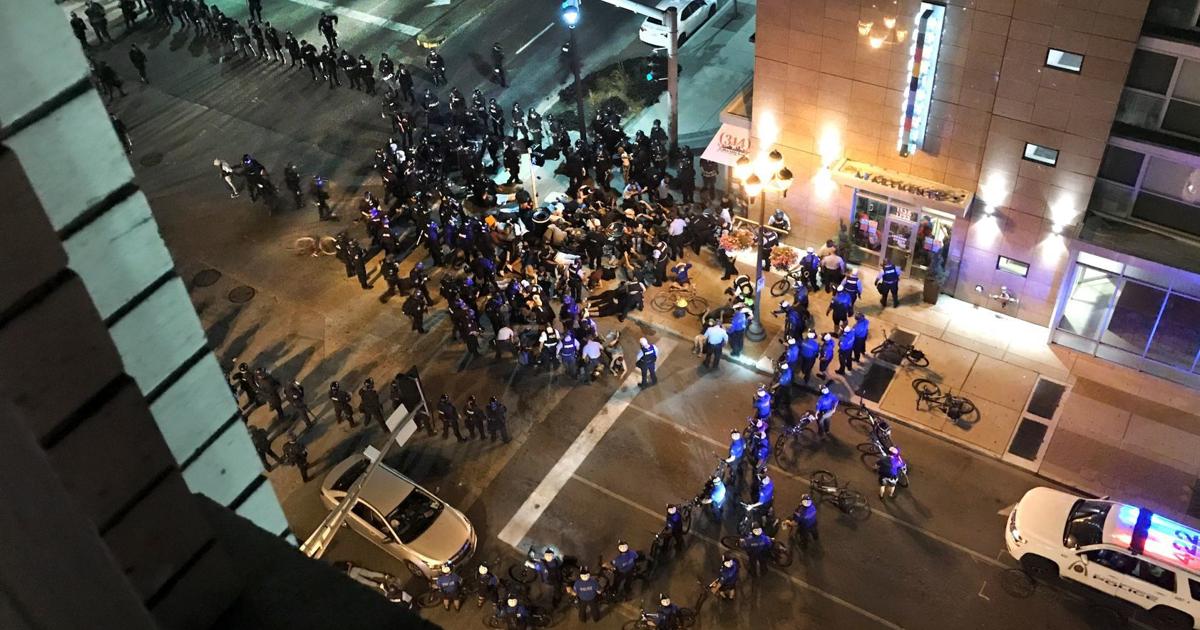StringerBell
OG

Los Angeles police officer charged with multiple rapes after DNA hit
The 10-year veteran of the Los Angeles Police Department could face life in prison after his DNA matched evidence in a 2015 cold case, authorities said.



Oklahoma court upholds sentence for ex-cop convicted of rape
OKLAHOMA CITY (AP) — A court on Thursday upheld the rape and sexual assault convictions and 263-year prison sentence of a former Oklahoma City police officer whose case has been watched closely by the Black Lives Matter movement and some conservatives.
The Oklahoma Court of Criminal Appeals unanimously rejected appeals by Daniel Holtzclaw that included a lack of evidence, excessive sentence, prosecutorial misconduct, a “circus atmosphere” during his trial and a failure by the defense attorney to present an expert to offer an alternative explanation to how DNA of one victim wound up on Holtzclaw’s pants.
Holtzclaw’s family said in a statement that it is devastated by the ruling, but not surprised. Holtzclaw’s father, Eric Holtzclaw, said the family plans to file a new round of appeals in federal court, a process family members said could take more than a decade.
“We will fight for Daniel until he is free,” his sister, Jenny Holtzclaw, told reporters. She said her brother was convicted because of “biased claims” by prosecutors and fabricated accusations by “unreliable accusers.”
“He deserves freedom. He is innocent of all charges that were brought against him,” Jenny Holtzclaw said.
Prosecutors alleged Holtzclaw, 32, targeted black women and girls while on duty. He was convicted in 2015 on 18 charges involving seven women and one girl that occurred in 2013 and 2014. He was acquitted on similar charges involving five other women.
The DNA of one of the accusers was found on Holtzclaw’s pants, but his appeals attorneys argued that could have gotten there through “secondary transfer” when he searched the 17-year-old’s purse. Holtzclaw argued that because his DNA was not found on his own pants, the pants were not properly tested and that the presence of his DNA mixed with that of the girl would support his claim of a secondary transfer.
But the court found that Holtzclaw failed to show how such evidence would support any theory of how the girl’s DNA got onto his pants.
Questions about DNA evidence were kept under seal by the court for 17 months because of personnel records that are confidential under Oklahoma law.
“This case involved a sexual predator who happened to be employed, most unfortunately, as an Oklahoma City police officer,” Presiding Judge David B. Lewis wrote in a specially concurring opinion to the 5-0 ruling.
“He used his position of authority to intimidate and prey on vulnerable victims,” Lewis wrote. “His arguments attacking the convictions are ... unavailing.”
In a statement, Jenny Holtzclaw took particular issue with Lewis’ comments.
“We vehemently disagree with the vicious and false assertion in Judge David Lewis’s concurrence that Daniel was a ‘sexual predator’ who abused his authority. It was detectives and prosecutors who abused their authority to manufacture false allegations against Daniel,” she said.
Eric Holtzclaw became emotional while describing the impact the case has had on his son and other family members.
“We know he’s innocent, that’s the big thing. He is 100% adamant about it. Our family is...it’s tough,” he said, fighting back tears. “We’re devastated, it’s no doubt about it.”
Oklahoma County District Attorney David Prater, whose office prosecuted the case, did not immediately return phone calls seeking comment. Alex Gerszewski, spokesman for state Attorney General Mike Hunter, whose office handled the appeal, declined comment, noting that the case is ongoing because Holtzclaw could appeal Thursday’s decision.
The executive director of Black Lives Matter Oklahoma City, the Rev. T Sheri Dickerson, said Holtzclaw was convicted because he is guilty.
“I celebrated in the fact that justice continues to be served,” Dickerson said. “The wheels of justice turned correctly.”
A 2015 Associated Press investigation highlighting the case found about 1,000 officers in the U.S. lost their licenses for sexual misconduct over a six-year period — considered an undercount because some states don’t have a method for banning problem officers.
A Chicago cop fatally shot a black teen who he says pointed a gun at him during a foot chase. But no gun was found — until 3 months later.
Chicago police Sgt. John Poulos told investigators he fatally shot 19-year-old Kajuan Raye in the back after the teen twice pointed a gun at him during a foot chase on the South Side.
But police found no gun by Raye or along the approximately two-block route of the chase in spite of extensive searches by dozens of officers that night and the next day in November 2016.
Nearly three months later, a resident raking leaves outside his West Englewood home — located along the circuitous path taken by Raye — discovered a silver-and-black semiautomatic handgun under bushes in his small front yard.
The find turned out to be critical evidence in the Civilian Office of Police Accountability’s controversial decision clearing Poulos of wrongdoing. While conceding that it was “troubled” by the lengthy passage of time that the gun had gone missing, COPA still concluded it was “likely and reasonable” that Raye had possessed the weapon as he fled on foot.
The ruling marks the second time that Poulos, who is white, has been cleared in a fatal shooting of a black man. In the first shooting, which happened in 2013, an off-duty Poulos thought 28-year-old Rickey Rozelle was armed when he saw him holding a shiny object near his waist, but no weapon was recovered, only a chrome-colored watch.
Poulos had also faced possible firing years ago on departmental charges alleging he concealed both a past arrest while applying to become a cop and his moonlighting as part-owner of a family bar. But in an embarrassment for the department, the Chicago Tribune reported in 2016 that disciplinary case had mysteriously fallen through the cracks for more than a decade. When the department subsequently tried to make up for the mistake by seeking to fire Poulos, the Police Board dismissed the disciplinary charges, citing the yearslong delay.
In addition to the discovery of the gun, COPA’s decision relied heavily on the account of Poulos, an officer with credibility issues because of the allegations he lied on his police application. Yet COPA didn’t even note in its report Poulos’ first fatal shooting three years earlier or the failed attempt to fire him over the alleged lies on his police application.
Some police officials also tried to downplay to COPA the effort that officers took that night to find the gun, but an attorney who represents Raye’s family in a pending federal lawsuit characterized the search as “massive."
Indeed, COPA’s report said as many as 100 officers took part in a coordinated grid search of the area for more than six hours that night. Police dogs, a truck equipped with a big light and even a helicopter were brought in to help. Fire Department officials used ladders to check out rooftops, and officers raked away leaves. Additional officers came back in the morning to search for more than another five hours.
Michael Oppenheimer, the attorney for Raye’s family, questioned how the gun could have been overlooked since the weapon recovered months later was “literally right on the path" of the foot chase outside a house he said had a well-manicured yard.
“It would have been logical that the gun would have been there, and they would have found it right away,” he said.
James McKay, Poulos’ lawyer, said COPA believed his client’s account of what happened “because what he said was corroborated by physical evidence, social media evidence and eyewitness evidence.”
McKay also said that no one can claim that the resident who found the gun three months later had “an interest, bias or motive to protect John.”
He also attacked Oppenheimer’s motives, saying he wants to make money in his lawsuit even though COPA’s findings dispute its allegations.
“Good God, when is this witch hunt against innocent police officers going to end?” McKay said.
In the days after Raye’s death, police Superintendent Eddie Johnson stripped Poulos of his police powers, saying, “I have concerns about this incident.”
But following COPA’s decision in April, Poulos’ police powers have been restored and the 18-year department veteran has returned to active duty assigned to work in the records division, according to a police spokesman.
‘He’s got a gun!’
The city’s Office of Emergency Management and Communications received an anonymous 911 call a little after 10 p.m. on Nov. 23, 2016, that a male wearing a black jacket and red hoodie was choking a female in an alley near Ashland Avenue and 65th Street.
City records show it wasn’t until an hour later, at 11 p.m., that Poulos — then a uniformed sergeant assigned to the Englewood patrol district, consistently one of Chicago’s most violent — spotted Raye at a bus stop near the alley.
COPA said Raye matched the caller’s description of the suspect but did not elaborate.
Poulos activated his unmarked vehicle’s emergency lights, pulled up by the bus stop, got out of the car and began to identify himself as a cop when Raye grabbed the waistline of his pants and took off running, according to COPA.
As Poulos gave chase on foot, Raye turned backward, extended his right arm and pointed a pistol with “a very large barrel” at him as he ran in a vacant lot, Poulos told COPA in a November 2017 interview.
Poulos shouted into his police radio, “He’s got a gun,” then drew his weapon and fired once at Raye from about 15 feet away, according to the report.
Several seconds later, Poulos told COPA that Raye extended his right arm a second time and pointed a gun in his direction.
“But, this time, he doesn’t even look at me,” Poulos told COPA under oath. “He just points it at me, and I still have my gun out, uh, and I fire one more time.”
As the pursuit continued, Poulos yelled to three civilians sitting on a porch, “He’s got a gun! Get down! Police!” the sergeant testified.
At one point during the pursuit, Raye appeared to toss something away, prompting Poulos to dive for cover, sliding into bushes and losing sight of the suspect, Poulos told COPA.
Other officers found the wounded Raye lying in a gangway off Paulina Street, COPA said, but its own report quoted Poulos as saying over the police radio at one point, “Get on the f------ ... get on the ground.”
COPA said Poulos denied he cursed despite the audio recording.
Raye was pronounced dead shortly before midnight at Advocate Christ Medical Center in south suburban Oak Lawn. An autopsy by the Cook County medical examiner’s office determined he sustained a single gunshot wound to his back.
No other officers interviewed by COPA said they saw Raye armed with a gun. Two civilian witnesses who saw portions of the chase also denied seeing a weapon in the suspect’s hands.
Poulos’ police vehicle was not equipped with a camera, but surveillance video from Nazarene All Nations Church captured the initial foot chase, COPA said. The footage showed both the officer and suspect with their hands at their sides, but the images were too grainy to tell if either held a gun, COPA said.
Only one officer among the several who took Raye into custody told COPA investigators that he heard Raye admit tossing a weapon during the foot chase. That same officer said the next day that an informant of his told him he had seen Raye toss a gun.
That informant later denied to investigators ever telling the officer he had seen the suspect possess or toss a gun.
Circumstantial evidence
On Feb. 19, 2017, nearly three months after the shooting, a man was raking leaves in the front yard of his home in the 6500 block of South Marshfield Avenue when he found a handgun. He told investigators he did not pick up the weapon. His mom called 911.
Two officers who responded to the call found the weapon lying beneath bushes at the front of the house. One later told investigators the gun — determined to be a loaded Kahr Arms CW40 pistol, a .40-caliber semiautomatic — was covered in dirt and had specks of rust around its magazine release.
At the police station, other officers quickly realized the weapon’s potential significance as evidence in Poulos’ fatal shooting of Raye.
In a recent interview, the man who discovered the gun told a Tribune reporter he remembered police searched his front yard and the entire block on the night of the shooting. He also told COPA that firefighters had looked on the roof of his house as well.
“They were searching pretty diligently,” the man, who requested anonymity because of the sensitivity of the case, told the Tribune.
COPA concluded that a preponderance of the evidence — more likely than not, a lower standard of proof than beyond a reasonable doubt used in criminal trials — showed that Poulos reasonably believed that Raye was armed with a gun.
While a footnote said that COPA was “troubled” that nearly three months had passed before the gun’s recovery, the report went on to call its discovery along the route of the chase “circumstantial evidence” that Raye had discarded the weapon.
Noting that the gun had been found “buried in a pile of leaves" beneath a row of hedges, COPA appeared to give some credence to testimony by several officers who had questioned the thoroughness of the hourslong searches. It also pointed out the gun was “speckled with rust, consistent with it being exposed to the elements for an extended period of time.”
In perhaps the strongest circumstantial evidence linking the recovered gun to Raye, COPA said a piece of black plastic and a silver-colored spring had been recovered from the front left breast pocket of the Pelle jacket believed to be discarded by Raye a short distance from where he was captured. The weapon found months later had only two pieces missing: its side panel and tension spring, the report said.
While an examination by an Illinois State Police forensic scientist could not definitively match the plastic piece to the recovered gun, COPA said, the gun’s manufacturer concluded from photographs that the black plastic was a side panel from a .40-caliber gun and the “trigger bar spring” was common to all Kahr Arms handguns.
COPA also found that Poulos’ account that Raye was armed was bolstered by his announcing during the foot pursuit that the suspect had a gun. COPA said it was unlikely that during such “a tense, evolving situation” that Poulos would have “the foresight to fabricate a purposefully false narrative.”
COPA also gave credence to the officer who reported hearing Raye say he had tossed the gun, though he was the only officer to say he did.
The report also said the officer’s claim that an informant had seen Raye discard the gun “was corroborated by the fact” that the pistol was later recovered about where the informant said he saw the gun tossed.
In its report, COPA said Raye used Facebook Messenger the day before the shooting to send a photo of what it says appeared to be the Kahr Arms CW40 pistol to another Facebook user.
COPA also said it found more than 250 photos of Raye posing with different guns in four Facebook and Instagram accounts believed to have belonged to him. He also sent hundreds of messages on Facebook trying to sell various weapons, the report said.
‘An imperfect record’
Stephen Rushin, a law professor at Loyola University Chicago who reviewed the COPA findings at the Tribune’s request, said he found the decision clearing Poulos to be reasonable given the circumstantial evidence and its standard of preponderance of the evidence.
“You’re working off an imperfect record, and you have to make the best decision that you can under the circumstances,” Rushin said. “... But I’m sure it’s not going to give people in Chicago a ton of faith in the CPD.”
Both Rushin and Locke Bowman, executive director of the MacArthur Justice Center at Northwestern University Pritzker School of Law, agreed that Poulos’ past, including allegations he lied on his police job application, would be valuable information for COPA to assess his credibility.
Bowman, who like Rushin specializes in police accountability issues, was much more critical of COPA’s findings, saying he felt there was little to show Poulos had a reasonable belief to think Raye was armed. He also questioned if COPA bothered to talk to the alleged choking victim to determine if she could identify Raye as her attacker.
“I don’t feel that COPA did its job,” he said.
He called the discovery of the plastic piece in Raye’s possession “ambiguous” evidence but acknowledged the social media evidence worked in Poulos’ favor.
Bowman said he is most bothered at the lengths the COPA report went to sound convincing that the gun found three months later was in Raye’s possession when he was shot.
“The Police Department was obviously very highly motivated to find a gun,” he said. “They had scores of officers searching in a systematic, grid-based approach. ... It’s really striking that under those circumstances they did not find this particular gun.”

In US news and current events today, an incident of police brutality from Fresno California has surfaced via police bodycam footage and possibly revealed that the Fresno police department lied. 17-year-old London Wallace was detained by Fresno police officers outside a cousin's birthday party. Police body cam footage shows Wallace being beaten by Fresno police officers. But this incident of Fresno police harassment might by some Fresno police corruption as officers claimed he was resisting arrest. Body camera footage might indicate that Wallace was not resisting.
